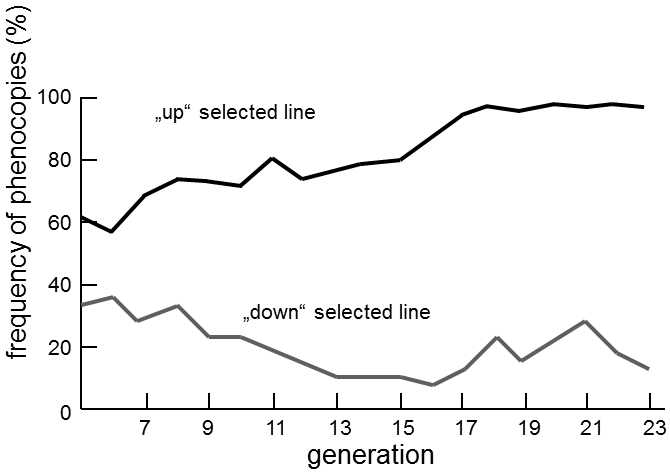XVI.3.2 Learned behavior may accelerate the adaptive evolution due to the Baldwin effect and genetic assimilation
This evolutionary creative role of learned behavior was described in the end of 19th century by the psychologist James M. Baldwin, and is thus called the Baldwin effect (Baldwin 1896). The Baldwin effect is often incorrectly identified with the genetic assimilation phenomenon (Waddington 1961), sometimes also called organic selection (Baldwin 1902; Matsuda 1982). Even though the principles of both phenomena were first described by Baldwin over an interval of approximately ten years, they are two complementary, but distinct and autonomous processes (Hall 2001). The Baldwin effect accelerates the evolution of adaptive traits in species capable of learning, increasing the chances of survival of individuals that are able to use a new source or are able to avoid a harmful factor using a learned behavioral pattern, thus creating scope for an evolutionary response to the particular factor by producing a number of various (genetically fixed) adaptations.
Genetic assimilationis responsible for genetic fixation of a phenotype trait originally produced non-genetically in the individual. For example, in the nineteen fifties, Conrad Hal Waddington observed that during artificial selection, a certain change of wing morphology in drosophila (absence of certain veins – i.e. cross-veinless phenotype), originally a response to heightened temperature during larvae ontogenesis of a small portion of the flies population, occurs in the offspring of altered individuals in further generations more and more often. After 23 generations of the selection, 96% of the flies respond to increased temperature by change of the wing morphology. Most importantly, the morphological change started to occur also in flies that were not exposed to increased temperature. (Waddington 1961; Grodnitsky 2001) (Fig. XVI.4). This means, that during several generations of selection for the ability to response to increased temperature through wing modification, a phenotype change that was originally conditioned by the environment (phenocopy) has become genetically dependent.

Fig. XVI.4 Genetic assimilation. With a low frequency, a population of Drosophila melanogaster produces mutants lacking the posterior transversal vein on their wings. If drosophila pupae are exposed to heat shock (40 °C) between the 21st and 23rd hour, phenocopies of the given mutation, i.e. flies with the same phenotype as the above-mentioned mutants, will be obtained in a considerable proportion of the individuals. The chart shows the progress of an experiment in which drosophilas were selected for higher frequency and for lower frequency of phenocopies in the population exposed to heat shock. In the line selected “upwards”, towards a higher frequency of phenocopies in the population exposed to heat shock, genetic assimilation occurred in the course of the experiment, resulting in an increasing proportion of individuals producing phenocopies, even when they had not been exposed to heat shock in the pupal stage. After Waddington (1953b).
At the present time, it is assumed that genetic assimilation occurs in that changed environmental conditions or a behavior pattern achieved by learning cause manifestation of already existing minor inter-individual genetically dependent differences in a particular trait in the individual members of the population (i.e. manifestation of latent genetic variability). Manifestation of these differences subsequently enables selection and thus genetic fixation of the new forms of the traits (Hall 2001; Flegr 2002). In the above mentioned hypothetical snail-shelling case, both genetic assimilation and the Baldwin effect can play a role. When the organisms start to exhibit a certain behavioral pattern, the so-far hidden differences in the predispositions of the individual members of the population for performing a certain activity, in our case the predispositions for snail-shelling became “visible” for natural or artificial selection. This enables spreading and finally fixation of already existing alleles that cause or at least facilitate development of a particular trait, e.g. launching a particular behavioral pattern (snail-shelling in a bird) or modification of wing morphology (in drosophila), even without the necessity to learn it individually or without any external stimulus.
Along with this, the Baldwin effect is responsible for the fact that selection makes this behavioral pattern more effective in time by suitable modification of the organism’s phenotype – e.g. by selecting birds with larger or stronger beaks.
